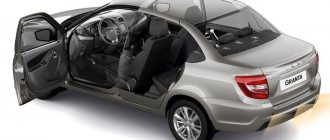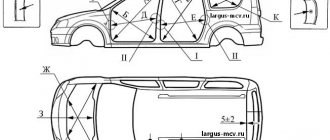The VAZ-2113 car was created in 2004 on the basis of Sputnik, the first Soviet front-wheel drive model VAZ-2108, popularly known as the “eight” and “chisel”. The car under the symbol 2108 belonged to the small class II group of cars produced by the Volzhsky plant and was produced from 1984 to 2003. The model was exported under the name "Lada-Samara". The new VAZ-2113 car was produced until 2013; a total of 72,359 cars rolled off the assembly line. European countries have always been open to an inexpensive model with good performance. The car was not supplied to the US and Canadian markets.
The VAZ-2113 became a technical replacement for the G8, its restyled version. Production of the updated model began after the launch of the Samara-2 project, which was focused on creating a car that was fundamentally different from the usual developments of the VAZ family, made on the basis of a license from the Italian Fiat. The project was a success, and Samara took its place in the new generation lineup.
Among other models
The front-wheel drive of the VAZ-2113 model was its main difference from the cars of the VAZ model range: the 01st “kopek”, the spacious VAZ-2102 station wagon, the reliable VAZ-2103, the stylish “six” and the representative of modern exterior forms, the VAZ-21043. The technical advantage of the machine was obvious in some other respects.
Since the VAZ-2113, a new model, was formally considered a repetition of the G8, the design bureau of the Volzhsky Automobile Plant adhered to all the parameters of the VAZ-2108. However, during the production that began, it was necessary to deviate from the established technological processes. This was due to the need for changes in the exterior of the new car, since direct copying of the contours, tail shape and other components was not allowed. What was needed were visual signs of new forms of the car, which was positioned as an independent model with a full set of individual technical characteristics.
Exterior
The front of the VAZ-2113 has changed radically; the simple rectangular block headlights that were on the V8 were abolished - they were replaced by stylish, horizontally elongated optics with an integrated yellow turn signal light. Combining several functions under one glass does not always benefit the appearance of the car, but in this case the decision was successful. The headlights of the VAZ-2113 organically fit into the tip of the front wings and hood. The lower bumper continued the panel of the engine compartment; an elegant strip ran across its entire surface, encircling the perimeter of the car. The doors are distinguished by a discreet, noble design; their lower part smoothly merges into the sill fairings.
Machine dimensions
When choosing a car, many people pay attention mainly to the size of the body. The larger it is, the more difficult it is to control the car, especially in dense city traffic. But at the same time, a big car is safer. VAZ 2113 is not large in size. The length is measured from the edge of the front bumper to the extreme point of the stock rear bumper. Width is the distance from one arch to another at the widest point of the body. Height - the distance from the ground to the top of the roof, the trunk and roof rails are not taken into account. VAZ 2113 has the following overall dimensions:
- length – 4 m 122 mm;
- width – 1 m 650 mm;
- height – 1 m 402 mm;
- weight – 975 kg (curb weight 1250 kg).
The luggage compartment is relatively small, its volume does not exceed 330 liters, but if you fold the rear row of seats it increases many times. This is one of the most important advantages of a hatchback.
Aerodynamics
The rear part of the “thirteenth” model passed from the VAZ-2108 practically unchanged, with the exception of the bumper and spoiler borrowed from the 2114 model. The slightly modified shape of the doors made it easier for passengers to enter, which previously caused many problems. New front fenders, a streamlined hood, an integrated bumper and organically integrated optics made the VAZ-2113 model exemplary in terms of aerodynamic qualities.
The car fit perfectly into the oncoming air flow, and the rear spoiler pressed it to the road surface, thereby ensuring good stability at any speed. The low body profile and relatively low ground clearance contributed to confident cornering. The car is characterized by a complete absence of rocking effect and never “scours” on the road, the ride is smooth.
VAZ-2115
A four-door modification that replaced the VAZ 21099. The VAZ-2115 became the first modification in the line of restyled cars of the family. Pilot production of the modified “99th” began back in 1997. The VAZ 2115 is equipped with a new trunk lid, front and rear optics, body-color bumpers, a trunk spoiler, side skirts and a number of innovations in the interior and electrical equipment.
VAZ-2115
The suspension, transmission and braking system are borrowed from models of the 2108 family, although their modernization was initially planned. The angular shapes in the exterior are a thing of the past. By lowering the rear edge of the trunk, loading things has become noticeably more convenient.
Particular attention was paid to improving electrical equipment. The equipment included: power windows for the front doors, PTF, and new headlights. In the luxury version, the car is even equipped with heated front seats. A trip computer that allows you to monitor the condition of the lamps, oil level, brake pad wear, and the level of coolant and washer fluids is included in any package.
VAZ-2115
From 1997 to 2000, the 2114 was equipped with VAZ-21083 carburetor engines with a displacement of 1.5 liters and a power of 71.6 liters. With. Since 2000, with the start of mass production, this power unit was replaced by a VAZ-2111 engine with distributed fuel injection. The volume remained the same, but the power increased to 77.8 liters. With. Since 2008, they stopped installing the VAZ-2111 engine, replacing it with the more advanced VAZ-11183, with a volume of 1.6 liters and a power of 80.9 hp. With.
Production of the VAZ-21099 continued until 2004, and then the old model was discontinued, completely replacing the “fifteenth”.
In 2008, the VAZ-2115 underwent minor changes, affecting mainly the exterior.
Chassis
The front suspension of the “thirteenth” model is an independent wishbone with a transverse stabilizer. Hydraulic shock absorbers combined with coil springs. The rotating axle is secured by means of two ball joints, upper and lower. The mechanism is connected to the rack and pinion steering. Rotation is transmitted to the front wheels using a constant velocity joint (CV joint), connected to the engine by two axle shafts through a gearbox.
The rear suspension is pendulum semi-independent, equipped with a transverse stability beam. Reverse action hydraulic shock absorbers are combined with reinforced coil springs. Initially, the model was produced with a conventional spring-shock absorber set, but during operation, an insufficient coefficient of helix resistance was revealed, and the rear suspension had to be strengthened.
The car's braking system is dual-circuit diagonal, with a vacuum booster. Pressure is supplied from the central cylinder. The front brakes are disc, non-ventilated. The rear ones are drum type with automatic clearance adjustment.
Interior
Thus, the parameters of the VAZ-2113 were revised towards updating. The “thirteenth” model received a more modern exterior design, as well as a radically changed interior.
The interior of the car was noticeably updated with the installation of a new dashboard of the “European panel” type, which differed from the previous one in a number of features: the glare that previously annoyed the driver disappeared, instrument indicators, arrows and digital symbols became better readable, the gasoline level and coolant temperature sensors were changed your shape for the better. The dashboard lighting has become softer and more diffused, which has a relaxing effect on the driver and passengers. The ceiling lamps were turned on remotely using a toggle switch on the center console.
The steering was modernized, the column became adjustable, its tilt was 12 degrees. This was enough to select the optimal position taking into account the driver’s height. The steering wheel rose and fell in a vertical plane within 80 millimeters.
The seats in the first row have changed shape, the cushions have become deeper at the junction with the backrest, and the backrests have been extended. The changes have added ergonomics to the seats and increased the overall comfort level of the car interior. The rear seat and backrest remained unchanged - their parameters did not need improvement. The lower part of the sofa easily rose, providing access to the fuel tank, and the raised back made it possible to communicate with the luggage compartment directly from the car's interior.
Unreleased VAZ model (9 photos)
A collection of VAZ concepts that will never be included in serial production; looking at them, one becomes completely sad about our domestic automobile industry.
Lada Roadster is a concern of the VAZ automobile plant, not allowed into production. For the first time, the Roadster was noticed at the MIMS 2000 car exhibition in the year 2000. The fundamental idea of the Roadster was the ability to retract the roof of the car into the trunk. Unfortunately, the demand for cars like the Lada Roadster is not great. But car manufacturers have always strived to have a stylish car with improved dynamic performance. AvtoVAZ wanted to implement a similar model on the basis of the 2108 car, which could be called “Lada Studio”. The car had a separate trunk and a removable roof. In the end, the car was completely redesigned, and approximately 500 cars were produced, which were delivered only to Europe and sold only there. Because of this unsuccessful model, a new one emerged - to release a high-quality car of the same class, which the Roadster should have been.
Lada Siluet, Lada-Siluet, VAZ-2116 is a concept car of a front-wheel drive sedan on the Project C platform, first demonstrated at the Moscow Automobile Show in 2005. A completely new front-wheel drive platform and a two-liter engine are being developed especially for the project. In the future, Diesel and automatic transmission variants are planned for production. It is alleged that this larger family car will feature an interesting exterior and interior design, high comfort, high-quality materials, neat assembly, enhanced safety, and that it is planned to launch the VAZ-2116 into production in 2015. Currently, crash tests of the prototype have been carried out, showing 13 points out of 16 possible according to the EuroNCAP system. In addition to the VAZ-2116 sedan, the Silhouette family includes the VAZ-2117 station wagon and the VAZ-2118 hatchback.
The new modification of the base model VAZ-2110 is a 4-seater limousine with a fairly high level of comfort characteristic of cars of this type. Various options for completing and finishing the interior of the VAZ 2110 “Consul” car allow you to use it for long tourist and business trips, as a representative car, as a taxi, it is possible to create a modification of the car for celebrations, as well as a version of the car with increased security. The design of the car interior provides a lot for comfortable accommodation of the driver and passengers. A soundproof partition allows you to create an autonomous compartment in the rear with a wide range of additional equipment and services. By increasing the length of the rear doors, free entry and exit of passengers is ensured. The aeroclimatic unit maintains a comfortable temperature regime for the cabin even with significant fluctuations in ambient temperature. Fatigue from a long stay in a static position is reduced by adjusting the position of the rear seats.
The LADA C project is a joint project of AVTOVAZ OJSC and the Canadian company, which provides for the creation of a series of C class cars. Existed in Russia from 2006 to 2009. “Project Lada C” provided for the joint creation of ten series of car models under the Lada brand at the existing facilities of AVTOVAZ. The launch of new models into mass production was scheduled for 2009. It was planned to create a joint venture, which would be headed by one of the Vice-Presidents of Russian Technologies, Maxim Nagaitsev. On December 22, 2006, a framework agreement was signed between the state corporation Russian Technologies and the Canadian company Magna International on cooperation in the production of auto components for the new project C. In 2009, cooperation with the Canadian company Magna International was frozen in favor of the Franco-Japanese Alliance Renault Nissan, the French company Renault acquired a 25% stake in AvtoVAZ. The Alliance provided its B platforms, which in 2012 were installed on the first line of the AVTOVAZ main conveyor. The head of the Russian Technologies company, Sergei Chemezov, said that the developments with Magna International remain in force and will be used to create new cars. Since 2009, due to the difficult economic situation of AvtoVAZ OJSC, “Project C” has been suspended.
Lada Karat is a Russian concept from AvtoVAZ. Introduced in 2002. The first development of the Lada Karat began in 2001. The dimensions of the Karat are not much different from the Oka. Its length is 300 mm longer and it is slightly taller than the Oka.
The prototype of the VAZ-2151 (aka Lada-Classic) was presented at the 2002 Moscow Motor Show. This was an attempt to modernize the classic Zhiguli: a completely new body was installed on the old rear-wheel drive chassis, the front suspension layout was changed, and a 1.7-liter engine with fuel injection was placed under the hood. The steering with a rack and pinion system was also different. Initially, the appearance of the car was supposed to echo the old VAZ-2101 and 2102 models, but in the end it was decided to abandon the round headlights and recognizable silhouette. It was assumed that the VAZ-2151 would not be a replacement, but a complement to the “classic” and would help AvtoVAZ increase production volumes. The start of production of sedans and station wagons was scheduled for 2006... As a result, the project did not receive further development, as it was considered unprofitable.
LADA SAMARA T3
Source: liveinternet.ru
fishki.net
Options
The VAZ-2113 model is supplied to the market in three versions: “Norma”, “Standard” and “Lux”. Standard equipment includes a heated rear window wiper, immobilizer, CO2 catalyst, on-board monitoring system, and adjustable steering column. The “Norma” set is practically the same as the “Standard” set with minor additions. The “Lux” package contains everything that is included in the first two sets, plus rear seat headrests, an on-board computer, athermal glass, and fog lights.
Specifications Features
If the body received minor changes, then the engine was seriously modernized. In the first VAZ 2113 models, a power unit from the Lada 2111 was installed - an injection unit with a displacement of 1550 cubic meters. cm. It had a distributed injection system and was practically no different from a carburetor engine; its power was 77 hp. With. Such engines were unpretentious and reliable, but far from perfect. Since 2007, models of the Samara 2 family began to be equipped with a new engine with the index 11183. Its volume is 1.6 liters and the rated power is 82 hp. With. It meets Euro-3 safety standards and regulations. The main distinguishing feature is the presence of a catalyst, which began to be installed in the engine compartment, and not under the bottom. Average fuel consumption ranges from 6.5 to 8 liters per 100 kilometers in the combined cycle.
The VAZ with index 2113 has a fuel tank with a volume of 43 liters. Under the hood you can see a plastic receiver - previously it was aluminum. The latest modification is equipped with an updated 1.6-liter engine. This 16-valve engine produces 89 hp. With. Some changes have been made to the transmission and clutch. Since 2007, an electronic gas pedal has also been installed. In 2010, a limited and last modification of the serial production VAZ 2113 was released. Under the hood, a 16-valve engine from Priora with a rated power of 98 hp was installed. With. The car received a significant increase in dynamic characteristics. The car was produced in various shades, there were about 150 in total. Of these, the most popular were “Quartz” and “Perseus”.
The main idea of creating a compact hatchback is dynamism and good suspension. The braking system is classic, with front disc brakes and drums installed at the rear. The front suspension has a MacPherson strut - independent with wishbones. The rear is semi-independent with a torsion longitudinal beam, springs and shock absorbers. The steering uses a rack and pinion, there is no power assist.
The transmission used is only a manual gearbox, which has no fundamental differences from the gearbox of other VAZ cars of the 10th family.
The car was supplied in three main trim levels: “Standard”, “Norma” and “Lux”. Each of them had its own characteristics. The basic package includes an immobilizer, rear window washer and heating, steering wheel height adjustment, and on-board control. The “Lux” added an athermal windshield, fog lights, powerful sound signals, head restraints for rear passengers, an on-board computer, and side mirrors with anti-reflective coating. Power steering, anti-lock braking system and air conditioning have never been installed on the VAZ 2113.
VAZ 2113 is one of the most convenient cars in terms of tuning and modifications. The main advantages are low cost and inexpensive spare parts. Like the legendary G8, the VAZ 2113 also became a real youth car with a sporty character. The car has already been discontinued, but will remain popular on the secondary market for a long time, so it will not disappear from the roads for many years.
Tuning VAZ-2113
It is usually customary to tune cars from the distant past. However, the VAZ-2113 model, being quite modern, involves radical changes in appearance in order to be able to change the image, as well as give the owner a chance to show his creative abilities. You can realize your plans if you have the technical equipment. Tuning a VAZ-2113 is, in any case, a fascinating creative process using modern technologies. The result depends on many factors, but can be impressive.











